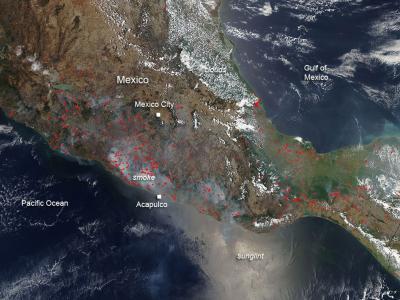In Guerrero, Oaxaca, Michoacan, Colima, and Jalisco regions (as well as others in the Yucatan Peninsula) of Mexico hundreds of fires were detected by the MODIS instrument on the Aqua satellite. The location, widespread nature, and number of fires suggest that these fires were deliberately set to manage land. Farmers often use fire to return nutrients to the soil and to clear the ground of unwanted plants. While fire helps enhance crops and grasses for pasture, the fires also produce smoke that degrades air quality. In Mexico, the agricultural burning season usually occurs several months (March through May) before the growing season of June through October.
This natural-color satellite image was collected by the Moderate Resolution Imaging Spectroradiometer (MODIS) aboard the Aqua satellite on May 02, 2013. Actively burning areas, detected by MODIS's thermal bands, are outlined in red.

In Guerrero, Oaxaca, Michoacan, Colima, and Jalisco regions (as well as others in the Yucatan Peninsula) of Mexico hundreds of fires were detected by the MODIS instrument on the Aqua satellite. The location, widespread nature, and number of fires suggest that these fires were deliberately set to manage land. Farmers often use fire to return nutrients to the soil and to clear the ground of unwanted plants. While fire helps enhance crops and grasses for pasture, the fires also produce smoke that degrades air quality. In Mexico, the agricultural burning season usually occurs several months (March through May) before the growing season of June through October.
(Photo Credit: NASA image courtesy Jeff Schmaltz LANCE/EOSDIS MODIS Rapid Response Team, GSFC. Caption by Lynn Jenner)
Source: NASA/Goddard Space Flight Center